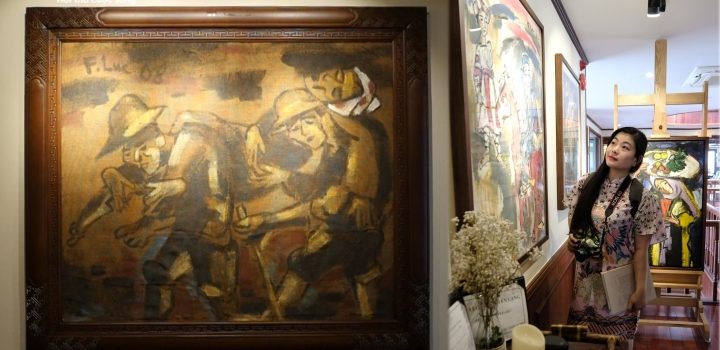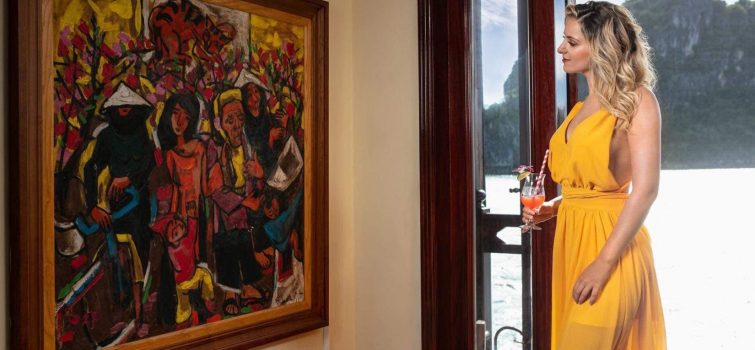The Picasso of Vietnam – Painter Pham Luc
Painting is like exercising for painter Pham Luc. If he doesn’t paint something every day he feels slightly ill, which perhaps explains his prolific output and reputation as Vietnam’s Pablo Picasso.
Born in 1943, Luc has been around paint brushes for some 70 years. From the age of three he tried to turn things into paint brushes. It could be a piece of brick or charcoal, a tree branch, or a stone, and everywhere was his canvas. Often, he was scolded by his neighbors, whose house walls he used to express himself. Luckily, he later found a wide sand bank by the riverside near his home, where he could paint on the sandy canvas with a tree branch.
Growing up during wartime, the young Luc became a soldier after graduating from the Hanoi College of Fine Arts (now the Vietnam University of Fine Arts). But his passion for painting never ceased. As one of his hands held a gun, the other always held a brush. His constant companion has been paper, a brush, and colors. “The mission of a painter is to record what he observes,” Luc explained, “Life is so colorful. I don’t want to miss a thing.”
At times so focused on not missing a moment of life, he in turn often missed a train or was taken advantage of by thieves. Losing his tools was a disaster because such things were scarce in wartime. Necessity, though, is the mother of invention. Again, he tried to turn things into a canvas, such as sackcloth or a hammock, which these days his fans crazily hunt for.
Luc never limits himself to a particular style either. From his studies he took on styles from the French school of European art, Chinese water colors in Asian art, and four of the most famous and successful Vietnamese painters since 1945. Nghiem, Lien, Sang and Phai, who all graduated from L’Ecole des Beaux Arts de l’Indochine, diverged on totally different paths, with Nghiem’s convention, Lien’s softness and femininity, Sang’s strength, and Phai’s realism, so Luc’s art reflects where East meets West. He also challenges himself to use different mediums including oil paintings, painting on rice sacks, lacquer, silk paintings, paper, and wood engraving.
After finishing his army service, he started different canvases in every corner of his home, which became his work space. When painting a lacquer work and getting some of the materials stuck, he may change it to an oil painting and continue in a different mood. “Just leave me alone in a room with brushes, colors and an old radio playing pre-war Vietnamese music and I’ll work spontaneously, by feeling, without sketches,” he said.
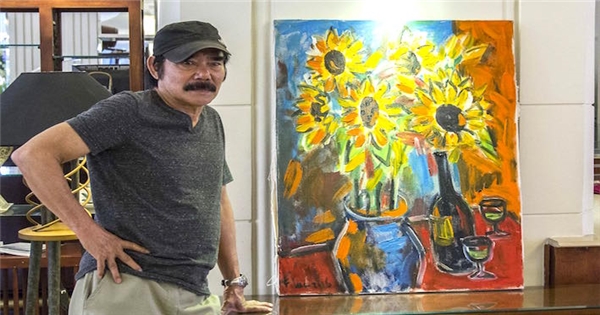
Due to regular headaches from high blood pressure, Luc has suffered from insomnia since he was 14. Many new ideas flash into his mind at night when he tosses and turns in bed. He usually has no idea whether it comes from reality or a dream, but he quickly gets the idea down on canvas. Whenever he touches a brush, his headaches ease and he feels like he is dreaming. The next day he sometimes forgets his nocturnal creativity, waking in the morning to be pleasantly surprised at the new addition to his collection.
Ben Wilkinson, representative of Harvard Kennedy University (now USA Fullbright University) in Vietnam, is a Pham Luc collector. He noted that “Pham Luc’s paintings are like windows that we can look through to understand more about the country and the people of Vietnam, both in the past wartime and the present.”
The characters in Luc’s paintings are also diverse, such as a local market, Tet paintings, heritage depictions of Quan Ho, Ca Tru and A Dao songs, Cheo or Tuong theatre the hero Thanh Giong, or the poet Nguyen Du. Women seem to inspire him more. It may be a woman in an old dress giving her son a bicycle ride during wartime, a woman looking for mussels in modern times, or an old woman selling some fruit.
His sympathy towards and love of women in his paintings brought him true love. A French woman who fell in love with his art bought many of his paintings on credit. Three years later she took him to a villa, which was the payment, and proposed to him. With his wife’s support, his paintings have been displayed in Europe and increased his fan base.
Among modern Vietnamese painters, Luc is the only one who has a fan club collecting his work. More than 100 of its members have some 6,000 of his paintings and regularly hold exhibitions. One, Tony Olive from Australia, who has 100 of Luc’s paintings, opened an exhibition in 2009 and every piece was sold. He felt regret at the scale of the exhibition’s success, however, and negotiated to buy back four of the paintings.
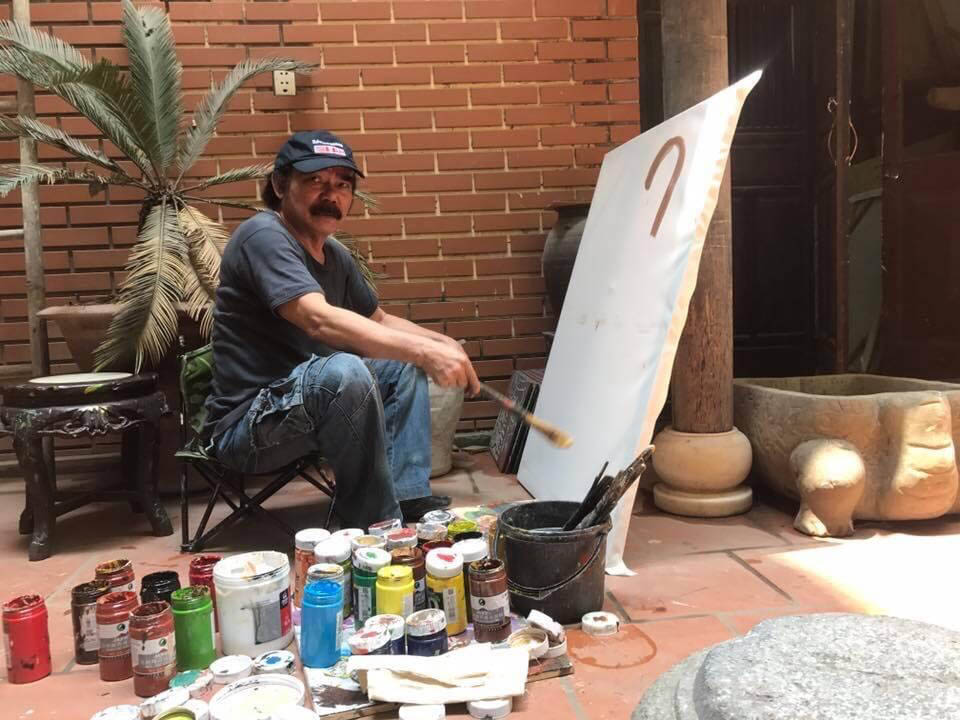
Paintings on Rice Sacks
Paintings on Rice Sacks have become synonymous with the artist Pham Luc in Vietnam. The artist, a former military painter, has experienced many battles in his lifetime. He indicates that the mission of the military painter is honest reflection about the life of people in the battlefield, what he observed and how he felt during the marches. The villages and people who helped him when he got hurt, and the fierce battlefields he passed through are featured in his works.
He painted hundreds of paintings on rice sacks made of jute or synthetic fiber rope from the Soviet Union and China. The idea to use rice sacks came about as he lacked the necessary materials to paint on, and rice sacks were plentiful.
He revealed that the first rice sack paintings were created with the artist Bang Lam in 1965. Pham Luc had to use lubricating oil from cars and trucks to draw because he lacked paints. Every character, image, and depiction in the paintings are associated with his military compatriots. Unfortunately, many paintings were damaged by bombs and ammunition.
War scenes often appear in his paintings, with subjects such as an old mother taking care of wounded soldiers, two teammates piggybacking injured soldiers back to the unit after a battle, a pregnant wife looking up at the image of her sacrificed husband, and militia girls carrying guns. Pham Luc also painted nudes on the sacks, a rather sensitive topic and a taboo in the military.
He had to use his imagination because there were no female models, and the finished pieces were often concealed. In one piece he depicts Vietnamese women soldiers taking a bath in the Truong Son Range after he had accidently come across them. In his paintings, those images bring a pure and romantic setting to the war.

Pham Luc has a distinctive style, one that reflects the culture and history of Vietnam. Many foreign and domestic collectors are proud of owning one or more of his rice sack paintings. In 2013, due to ill health, the artist stopped drawing and exhibiting this type of painting. Because of these changes, the rice sack paintings have become more sought after.
When asked why he had quit painting on rice sacks, the artist explained, “This was my toughest decision, but I’m very happy about my first exhibition without rice sack paintings. In any solo or collective exhibition, the rice sack paintings always make me different. This material reflects the misery of the whole nation at the time, and that has touched many people. But I think nothing is forever nowadays. The artist must also portray life with pen strokes and canvas.”
In a recent interview with writer Nguyen Ngoc about Pham Luc, Thomas J. Vallely, Director of the Harvard Vietnam Program, said his favorite place in Vietnam was not a city or a town but Luc’s concrete studio house. Whenever he visits Luc he talks about art and has learned new things about Vietnam, past and present. He sees Luc’s work as being rich in culture, history and heritage, through varied and diverse themes, with an artistic language on war and the difficulties and sorrows of life, making his creative value not just Vietnamese, but universal.
DISCOVER VIETNAMESE CULTURE THROUGH PAINTINGS
Exhibiting both French and Vietnamese influences in his work, Pham Luc is a bridge linking the 20th and 21st centuries. To appreciate this accomplished and yet humble master is to understand a part of Vietnamese culture, history, heritage, progress and life.
Some of his older paintings sold for over $400,000 and many have admired his works including a Harvard professor, many ambassadors in Hanoi, high-ranking Vietnamese officials and art collectors from around the world. He has a collectors’ club with over a hundred passionate members in Hanoi.
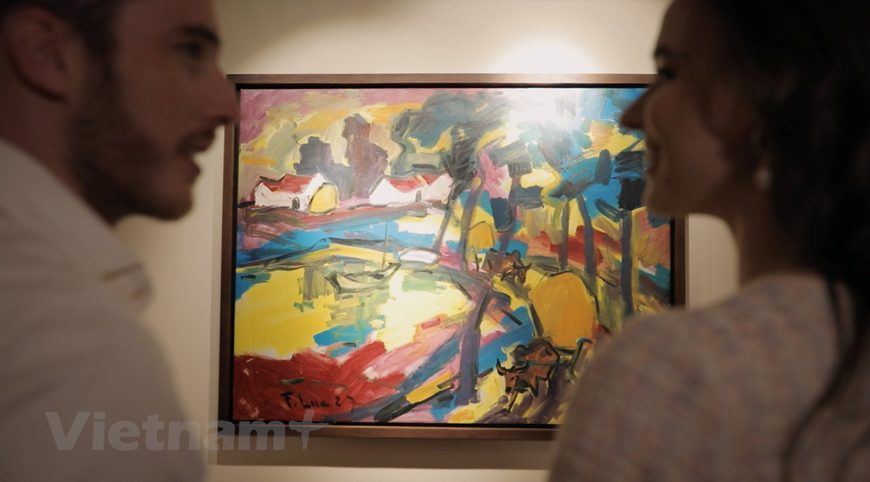
Soldier and Painter
Pham Luc was born in Hue, Vietnam in 1943 and raised in Hanoi. He was one of the official painters in the Vietnamese army and was awarded prizes in art from the Ministry of Defense in 1990. He still lives in Hanoi and is one of the major painters in this country. His works have been exhibited in France, Germany, USA, Australia, Singapore, Japan and Russia and feature in the collections of Vietnam’s Fine Arts Museum and many international art collectors.
His style
Pham Luc’s style is instantly recognizable but hard to imitate. “I do not paint in abstract. I paint the vibrations of my heart, the life of the people around me… I find serenity in working. My paintings are confessions.”
It is in these terms that the painter describes his style which is full of French influences. In his art Pham Luc exalts the simplicity of rural beauty through the sweetness of women, children or nature.
Pham Luc is influenced by four of the most famous and successful painters in Vietnam since 1945 – Nghiem, Liem, Sang and Phai who all graduated from L’Ecole des Beaux Arts de l’Indochine. These four artists diverged on totally different paths. Nghiem in a world of convention, Liem softness and femininity, Sang was strength, and Phai realism.
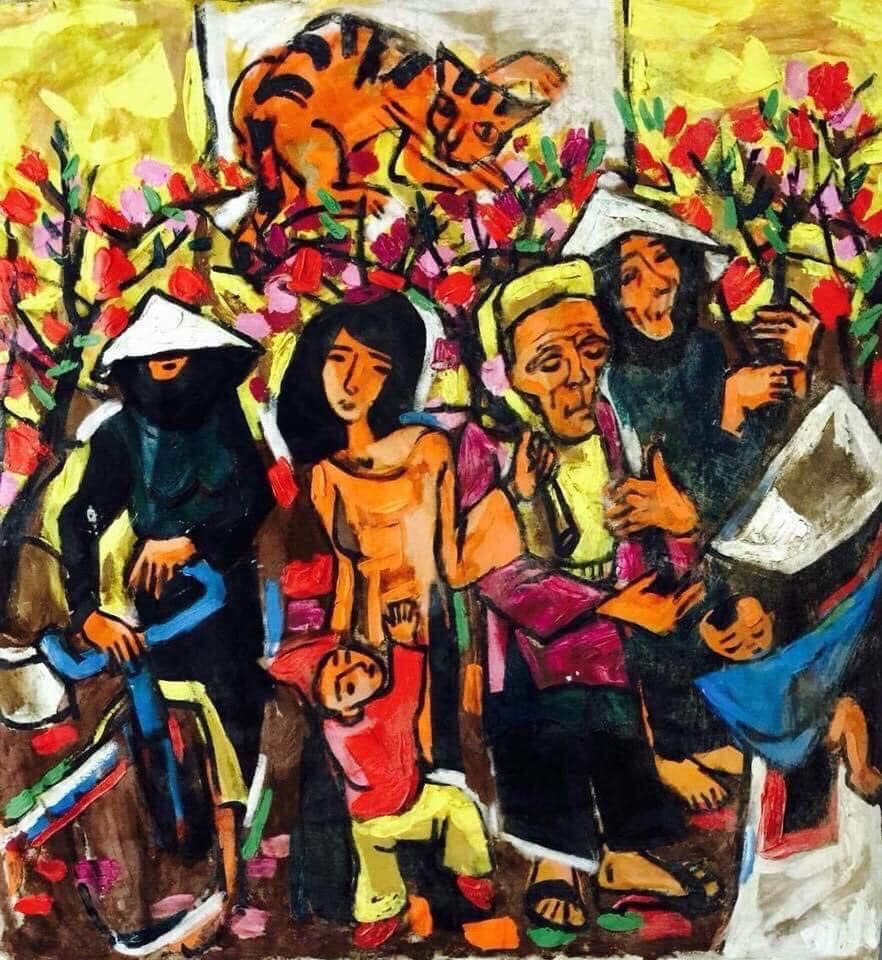
His life as a painter “Painting is my joy in life.”
Pham Luc tirelessly paints nearly a thousand paintings every year. What characterizes him is his ability to adapt to the element he is using. He has created works of art on all possible media: newsprint, craft paper, rice sacks. He also mastered the traditional techniques such as oil, gouache, ink, pastel, and lithography as well as lacquer, deemed the most difficult technique, and inaccessible to many. He is one of the acknowledged masters in this medium.
Pham Luc and war
Pham Luc spent 35 years in the army and was one of the official army painters. Much of his art was produced in haste during the war, on sacks of rice, and bore witness to the horror of the fighting that surrounded him. Art silenced the horror and introduced the essence of hope.
One particular technique: Lacquer
Initiated in China three thousand years ago, the technique of lacquer then spread throughout Southeast Asia. In Vietnam, where lacquer is recognized as a popular art and craft, the process, a long kept national secret, was allowed to be shown to foreign students around 1970 by the Hanoi Fine Arts College. What characterizes it is the application of several layers of color dried in a hot and humid atmosphere. Thanks to grinding techniques, different shapes and colors can be brought out.

Work in ink
Pham Luc’s ink works, painted on locally available materials such as silk, rice sacks, newsprint, and rice paper, are of inestimable historical value. Made between 1965 and 1975, a series of drawings in ink on rice paper represent the soldiers, Vietnamese peasants, and women during the war, mostly passive witnesses of a conflict for unity and independence.
Oils and other techniques
Pham Luc mastered many traditional techniques: from lacquer (he is an undisputed master in Vietnam), water color, oil, woodcarving, and gouache to acrylic. A book that compares him with Picasso is dedicated to him.
 A masterpiece in the natural wonder
A masterpiece in the natural wonder
Built with passion, Heritage Cruises is proudly affiliated with the master Pham Luc as travel, cruising, food, wine, hospitality, music and art represent our rich Vietnamese history, culture, nature, heritage and cuisine which all create memories for the most sophisticated travelers. Discover our masterpiece and 100 artworks on board and create your own memories.
Paintings depict both the cultural heritage and the historic values of a nation
On the occasion of Pham Luc’s most recent exhibition from 24 April to 6 May 2019, with the meaningful title ‘Xuan 2019’ (“Spring 2019”), the shortest introduction I have ever seen summed up his life of art as “35 years in army service, 55 years as an artist and 77 years of being a Vietnamese. My motivation continues to be to use my life experiences as a source of inspiration to create works of art.”
Pham Luc – a celebrated artist who creates pieces of art from images that he has seen in his dreams. Pham Luc, the creator of thousands of pictures of various sizes, styles and materials, some of which you can admire aboard Heritage Cruises, shares with us his vision, passion, war memories, and life as a soldier and artist.
Pham Ha: You were born in Hue, your father’s home town, and lived there until 1945, when you moved to Ha Tinh at the age of three, your mother’s homeland. After graduating from the Vietnam College of Fine Art in the mid-1960s, you joined the Vietnamese army. Was becoming a soldier and an artist serving in the army your only choice at that time?
Pham Luc: My father was a junior mandarin in the Nguyen Dynasty. He met my mother in Ha Tinh, and she gave birth to me when they lived in Hue. In 1945, there were plenty of political fluctuations due to the stiff resistance of Vietnamese inhabitants against the French protectorate in Hue. It was feared that there would be a revolution, so my father sent his wife and three children away from Hue to settle down in the central coastal province of Ha Tinh.
I grew up in my mother’s home town and, as a little boy, I was passionate about drawing, which I was very good at in school, rather than other subjects. After finishing secondary school, I went to Hanoi to study an intermediate art course at the Vietnam College of Fine Arts. I graduated and worked at the Cultural Department of Ha Dong in Ha Tay province (now Hanoi) for a short period of time, then joined the Vietnamese military.
At that time, all my classmates volunteered for the army as there was a lot of spirited nationalist fervour in North Vietnam. Everybody wanted to join the army, rather than stay at home, as they felt that they wanted to do something to fight to bring about the nationalist ideal of unifying both North and South Vietnam.

Pham Ha: Do you think that abiding by rules and following orders in the army was difficult for you as an artist, and your creativity was restricted?
Pham Luc: In the army, I chiefly worked in the Military Literature and Arts Department, mainly teaching drawing. Every 3 months, we had a new class of young soldiers to train who were either involved in propaganda or were sent to fight in South Vietnam, Laos and Cambodia.
Sometimes, I had to go on temporary assignments to various army units to teach drawing. My role in the military did not prevent me from my own artistic creations, as during this time I had the opportunity to learn about different techniques in terms of mesh printing, silk printing, and lacquerware. Prior to joining the military, I learnt how to use a variety of materials for drawing, including on canvas, and attended a graphics class at the college.
Visiting different military units, getting acquainted with the daily routines of the soldiers and indigenous people, gave me a lot of ideas for paintings.
Pham Ha: From the number of your paintings that still exist from the war period, it is clear that you weren’t able to paint as much as you would have liked, but these paintings have made a strong impact on fans of your work because of the subject matter, the material used, the colors, and the brushes you used. Was this the most extraordinary period of creativity for you?
Pham Luc: Due to the situation I found myself in during the war, there was no place for me to store my work safely, so there were many more drawings but not all of them survived.
The Military Artist Studio was provided with art materials from a variety of countries, like the Soviet Union, China, and East Germany; we had enough colors to choose from, but the material available was mainly burlap. Therefore, we had to paint a layer of egg white or cowhide glue before we could start to paint and, as a result, the pictures easily became mouldy and deteriorated.
Wartime conditions did not allow me time to paint at leisure, but I was passionate about drawing and created a lot of pictures at high speed. I took advantage of the jute bags used to store guns, ammunition, and medicines or the linings which contained machinery components and then “made up” some basic colors from motorcycle exhaust, soot, and car paint.
The war was the second stage of my creative process, which started when I was at college. In school I drew from instinct, learning the rules from my teachers. In the army, however, I was older and more mature, no longer young and inexperienced. Moreover, the struggle of my people affected me deeply and I drew on many new emotions for my drawings.
When we were being attacked, with loud explosions from bombs and gunfire, it was impossible to work on my art. But the depth of my emotions in such difficult situations, and my ability to paint quickly, meant that my work came from the heart and reflected the spirit of the people around me.
Pham Ha: Your quick and expansive brushwork has become your easily recognized bold and impressive style since the war. Is it important that you portray an overall impression in your work rather than concentrating on details?
Pham Luc: I remember a Vietnamese folk verse: “Trên đồng cạn dưới đồng sâu. Chồng cày vợ cấy con trâu đi bừa.” (The upper field is dry, the lower one is deep/Husband plows, wife transplants rice seedlings, buffalo tilling).
If you consider the detail you would start to wonder who is doing the plowing, whether the buffalo does it on his own or is he guided by the husband to keep the furrows straight. Generally, people don’t pay much attention to the detail; they focus on the overall impression of the image, the people and animals at work. Art is the same, there is no need to depict detail.
When I was learning the techniques of painting at school, my work was guided by others, just as the buffalo is guided by the farmer. By restricting myself to the style I was taught, I would not have been able to pursue my own creativity. Images and emotions come to me in my dreams and I feel that these are sent to me so that I can draw them
Pham Ha: Do you find you are continually looking for new subjects and styles as you still want to improve, even though you are so successful?
Pham Luc: Although my art does not go into detail and there are no specific answers in the content of the paintings, the overall images in the drawings convey my thoughts and feelings.
A beautiful painting can pose questions for the viewer as it is not always easy to understand the message conveyed by the artist. It is a challenge for the viewer to understand and acknowledge the familiar images.
I don’t make sketches before I start to paint, but I do plan in my head what I want to do. Some of my images are quite abstract but overall the paintings, and in particular the colors I use, illustrate the type of characters that came from the dreams that have inspired me.
Pham Ha: As a painter and soldier, you have lived in in both the 20th and 21st centuries, through three wars. You have painted when at war and in peace time, have your life experiences enabled you to understand all the many aspects of Vietnam and how it has progressed? Personally, your artworks and memories about the war have touched my heart and your paintings of people’s lives, culture, costumes, and heritage are an important contribution to the preservation of Vietnamese historical and cultural values. What are your thoughts on this?
Pham Luc: An artist paints their personal perception of the world through composition, color and images. Paintings depict both the cultural heritage and the historic values of a nation. Culture because paintings reflect the observations of our surrounding world, expressing its uniqueness. Historic values because the paintings depict our lives, joys, and sorrows in the past, present and future. I am so happy that art collectors and luxury cruise owners have collected my work to show art lovers and the younger generation the natural and cultural heritage of our country, and to help them appreciate the work of local artists and understand our culture and history and, in particular, the progress of Vietnam in recent times.
Thank you for your sharing your memories and thoughts with us in this exclusive interview.


